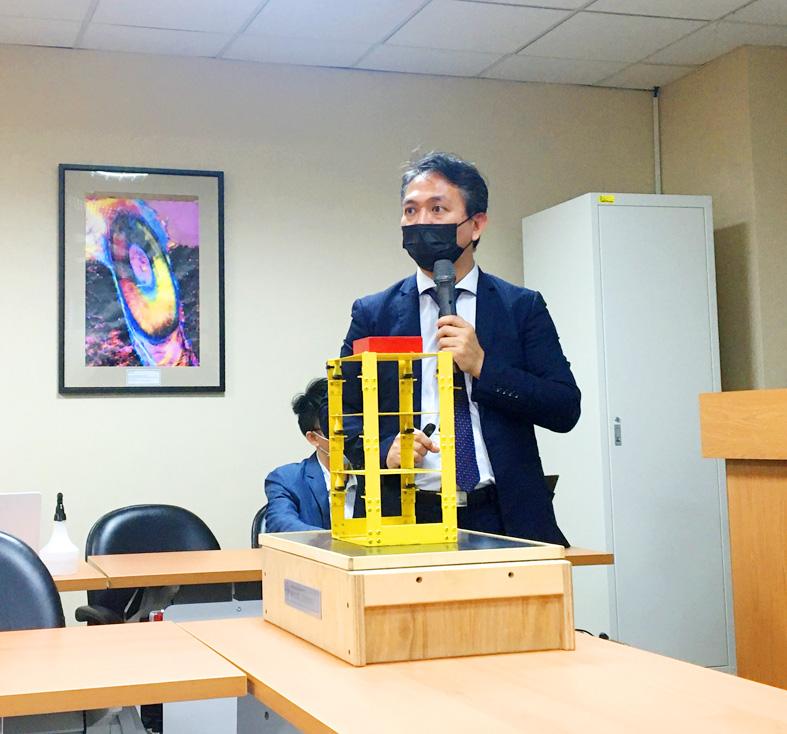A “5D” smart city disaster prevention system that aims to help minimize damage to buildings from earthquakes yesterday was introduced by the National Center for Research on Earthquake Engineering.
The center's previous 4D system has integrated the Central Weather Bureau's data, while the 5D system shows estimates of damage that buildings might sustain during a quake, center research fellow Wang Ren-zuo (王仁佐) told a news conference in Taipei.
The levels of damage are divided into five tiers from “undamaged” to “collapse,” Wang said.

Photo: Lin Chia-nan, Taipei Times
The system can forecast which buildings in a region are more likely to collapse, he said.
During a tremor, the system can swiftly gather seismic data and when the shaking is finished, it can indicate the best routes for rescue workers and evacuations, he said.
If authorities employ uncrewed aerial vehicles to inspect damaged regions, images they take can be incorporated into the system, which has image recognition algorithms, he said, adding that this would enable authorities to assess the scope of losses.

Photo: Screen grab from a video provided by National Center for Research on Earthquake Engineering
For example, if a building partially falls over — as the Yun Men Tsui Ti (雲門翠堤) building in Hualien City did following liquefaction amid a magnitude 6.2 earthquake in 2018 — the system can compute the best way to prop it up to help prevent further damage if there are aftershocks, Wang said.
If there is a power outage, the system can be supported by an emergency power system, center director-general Chou Chung-che (周中哲) said.
So far, the center has only finished building spatial models for Hualien City, Wang said, adding that it hopes to collect more architectural data from other local governments.
Other features of the system are integrated subsystems for structural health monitoring, estimates of the cost from damage, an assessment of damage to water supplies and analysis from remote-sensing data collected by the Formosat-5, which was launched in 2017, he said.
It is significant that the center has full control over the system’s infographics, given that it was developed entirely in Taiwan, he said.
The center hopes to initially deploy the system in the social housing units in Taoyuan and the Shalun Smart Green Energy Science City in Tainan, he said.
In addition, the center is partnering with the Ministry of the Interior’s Construction and Planning Agency to strengthen the structures of old buildings across Taiwan, as many are vulnerable to earthquakes, Chou said.
However, members of the public are normally not willing to share information about their homes online, he said.
Hopefully, people can work with the government to improve building safety, he added.

Chinese Nationalist Party (KMT) Chairman Eric Chu (朱立倫), spokeswoman Yang Chih-yu (楊智伃) and Legislator Hsieh Lung-chieh (謝龍介) would be summoned by police for questioning for leading an illegal assembly on Thursday evening last week, Minister of the Interior Liu Shyh-fang (劉世芳) said today. The three KMT officials led an assembly outside the Taipei City Prosecutors’ Office, a restricted area where public assembly is not allowed, protesting the questioning of several KMT staff and searches of KMT headquarters and offices in a recall petition forgery case. Chu, Yang and Hsieh are all suspected of contravening the Assembly and Parade Act (集會遊行法) by holding

PRAISE: Japanese visitor Takashi Kubota said the Taiwanese temple architecture images showcased in the AI Art Gallery were the most impressive displays he saw Taiwan does not have an official pavilion at the World Expo in Osaka, Japan, because of its diplomatic predicament, but the government-backed Tech World pavilion is drawing interest with its unique recreations of works by Taiwanese artists. The pavilion features an artificial intelligence (AI)-based art gallery showcasing works of famous Taiwanese artists from the Japanese colonial period using innovative technologies. Among its main simulated displays are Eastern gouache paintings by Chen Chin (陳進), Lin Yu-shan (林玉山) and Kuo Hsueh-hu (郭雪湖), who were the three young Taiwanese painters selected for the East Asian Painting exhibition in 1927. Gouache is a water-based

Taiwan would welcome the return of Honduras as a diplomatic ally if its next president decides to make such a move, Minister of Foreign Affairs Lin Chia-lung (林佳龍) said yesterday. “Of course, we would welcome Honduras if they want to restore diplomatic ties with Taiwan after their elections,” Lin said at a meeting of the legislature’s Foreign Affairs and National Defense Committee, when asked to comment on statements made by two of the three Honduran presidential candidates during the presidential campaign in the Central American country. Taiwan is paying close attention to the region as a whole in the wake of a

OFF-TARGET: More than 30,000 participants were expected to take part in the Games next month, but only 6,550 foreign and 19,400 Taiwanese athletes have registered Taipei city councilors yesterday blasted the organizers of next month’s World Masters Games over sudden timetable and venue changes, which they said have caused thousands of participants to back out of the international sporting event, among other organizational issues. They also cited visa delays and political interference by China as reasons many foreign athletes are requesting refunds for the event, to be held from May 17 to 30. Jointly organized by the Taipei and New Taipei City governments, the games have been rocked by numerous controversies since preparations began in 2020. Taipei City Councilor Lin Yen-feng (林延鳳) said yesterday that new measures by